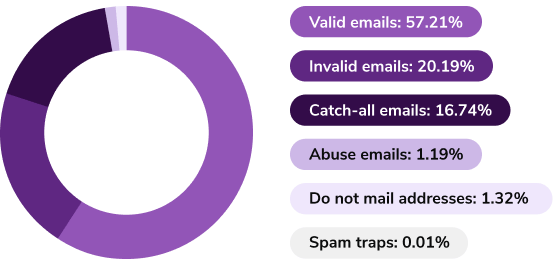The Email List Decay Report for 2024
See how fast your email list goes bad – and what you can do to keep it healthy




At least a quarter of your email database may have degraded in the past year. ZeroBounce’s Email List Decay Report for 2024 unveils exclusive, never-before-published data to help you get more out of your email list.
Building an email list is one of the smartest things you can do for your business. With more than four billion users worldwide, email is the lifeblood of transactional communication. As a marketing channel, it allows for unparalleled ROI opportunities. There are even million-dollar businesses run exclusively through email.
But for email marketing to work, great content can only make an impact if you actually connect with your prospects. So first, you need a healthy, valid email list. And much like your business and customer base, email lists are ever-changing.
A contact valid yesterday could be invalid today if that person left their job. In the past few years, pandemic-related layoffs, business shut-downs and The Great Resignation have caused email data to decay even faster. People also switch to different email services and abandon their old addresses. We’ve all done it at least once.
Email list management thus becomes an ongoing purpose.

How does email list decay affect the health of your email list over time? Does obsolete data lower your email deliverability? What can you do to always keep your email list fresh?
The ZeroBounce Email List Decay Report for 2024 answers these questions – and more. In this study, we bring exclusive insights into the dynamic lifecycle of email lists. Use this data to build your database the right way, increase email list engagement and hit your marketing goals in 2024.
The Email List Decay Report for 2024: Average email list health statistics
ZeroBounce validates billions of email addresses yearly. We learn a lot from the data we process – and now, we share our findings with you.
To create this report, we looked at all the email data we verified between January and December 2023. Then, we analyzed the overall email validity for previous years and compared these two data sets to understand better how email lists degrade.
Our customers range from solo business owners to behemoths like Amazon, Disney and Netflix, so the findings below reflect statistics across various business sizes and industries.

Summary of email decay: how quickly do email lists degrade?
• At least 25.74% of an email list degrades yearly. • The most prevalent type of risky emails found in email lists are invalid addresses. • Catch-all emails make up the second-largest segment of email addresses that are likely to bounce. • People make an astonishing number of typos when trying to sign up for emails. In just one year, ZeroBounce prevented 10+ million bounces through typo detection. • Disposable emails are a common way people avoid giving out their real email addresses. Last year, ZeroBounce identified 5+ million disposable emails. • Email validity was 3.03% worse in 2023 than the year before. • Only 56% of all emails submitted to ZeroBounce in 2023 were valid.
How many of your emails are valid?
Overall email list data decay in 2023
In 2023, ZeroBounce’s email list cleaning software processed more than seven billion email addresses – in bulk and in real time. How many of those emails were valid? Take a look below.
Here is a breakdown of the overall email list decay our software has identified:
ZeroBounce data from January 2023 – December 2023

How quickly does email list data decay?
On average, at least 25.74% of an email list decays within just one year.
Out of the data we analyzed, 20.94% were invalid emails. However, invalid email addresses aren’t the only types of contacts risky to your email deliverability. As you can see above, email databases can also acquire:
- Abuse emails: These are known complainers who have a history of reporting many emails as spam. To preserve your email list hygiene and ensure the highest inbox reach, we recommend you don’t send emails to these contacts.
- Spam traps: Set up by Internet service providers (ISPs) and blacklist providers, spam traps are designed to detect and block spammers. Although ZeroBounce spotted only 0.01% spam traps in 2022, hitting a spam trap is a blow to your sender reputation and email deliverability. Read more about spam traps here to understand why they don’t belong on your email list.
- Do-not-mail addresses: ZeroBounce uses this email validation status to group several kinds of poor-quality and risky contacts. These contacts include role-based emails, disposable emails and spam and bot-created emails. Make sure to remove these contacts from your database to maintain your reputation and help your emails go to the inbox.
Related: Learn more about the different ZeroBounce email statuses and what they mean
Catch-all emails are a special breed
We stated above that at least 25.74% of an email list decays within 12 months. Catch-all emails are the reason why you should consider this percentage only a low-end estimate.
In 2023, ZeroBounce found that 15.07% of all the emails it checked were catch-all emails. Now, some catch-all emails are valid and safe to use, but others are not.
Related: Learn more about catch-all emails
Catch-all emails are associated with domains that accept all emails sent to them – even if the email address does not exist. They are impossible to validate without emailing them and waiting to see if they bounce. Non-existent catch-all email addresses will end up bouncing and hurting your sender reputation. Proper email list management will help you stay aware of these risky emails.
Bonus tip:
Email validation results for bulk and real-time verifications
ZeroBounce verifies emails in bulk and in real time, through the email validation API. Next, let’s break down the results from both email verification methods.
Bulk email validation results – identified when users uploaded existing email lists:
ZeroBounce data from January 2023 – December 2023

Real-time email validation results – detected by the ZeroBounce API:
ZeroBounce data from January 2023 – December 2023

2023 email list decay by the numbers
Percentages paint a broad picture of how much email lists degrade in a year. But let’s look at the actual numbers to get an even better idea of the amount of bad data lurking in email lists.
In 2023, ZeroBounce identified:

Email validity between 2021 and 2024
In 2023, ZeroBounce found that at least 25.74% of all emails it checked were invalid and risky. Was that percentage higher or lower in previous years?
We tracked that data, and here’s what we found:
Email list decay in 2022: a total of 22.71% of all emails were risky

Email list decay in 2021: a total of 23.16% of all emails were risky:

Our data shows that email lists contained more outdated contacts in 2021 than in 2022. The higher percentage from 2021 could have been a residual effect of pandemic-related layoffs and businesses closing. Another significant contribution to data decay was “The Great Resignation” trend that started in early 2021. A year later, overall email validity improved by 0.45%.
Other captivating facts from ZeroBounce’s email verifier
We gathered these benchmarks to help you build healthier and more effective email lists. Aside from the stats above, the numbers below gave us extra insights into the email data landscape.

Here’s what stood out in 2023:
• Between June 2018 and December 2023, ZeroBounce validated more than 25.5 billion email addresses. Most of this data came from bulk uploads. • More than 1.5 billion emails were invalid. • The number of ZeroBounce API users has increased steadily through the years, with a total of 67,500 by December 2022.
• The ZeroBounce email validation API helped prevent more than 10 million bounces by detecting typos made in sign-up forms as users were trying to input their contact details. • The API prevented an additional 5+ million bounces by detecting disposable emails. Some of these emails have a short life – sometimes as short as 15 minutes – and are sure to bounce. • Abuse emails (known complainers) are more prevalent than you’d think. Across the bulk and real-time email list cleaning services, ZeroBounce found more than 126 million known complainers. • Our email checker detected more than 1 million spam traps. Spam traps can’t sign up for emails, so remember never to add any contacts to your email list without permission. • More than 1 billion of the emails ZeroBounce verified were catch-all emails. • Only 56% of all emails submitted to our platform were valid.
How often should you clean your email list?
To keep email decay at bay and protect your sender reputation, clean your email list at least once a quarter. If your database grows quickly, run it through our email verifier every month.
Want to take a step further to preserve your email list hygiene? Connect our API to your CRM and any platforms you use to gather leads. Once set up, the API checks every new sign-up in real time so that no invalid and fake emails can make it to your list.
How to prevent data decay and keep your email list healthy
Email list decay is inevitable. Even the most diligent email marketers will still acquire risky emails in their databases. So fixing and preserving the quality of your email list takes consistent care – but it’s easy to do!
Let’s look at some best practices you can follow to keep your email list clean, protect your sender reputation and land more emails in the inbox.
Build your own email list
Purchasing or renting an email list isn’t a shortcut to faster results but rather a direct path to the spam folder. First, it’s highly unlikely to convert prospects who’ve never heard of you. What’s more, you can get a deluge of spam complaints that hurt your sender reputation and direct your campaigns to the junk folder. So, instead of buying one, build your own email list by promoting it consistently across all channels. Preventing email list decay is easier when you start off with valid contacts.
Use double opt-in
Setting it up takes minutes and prevents your email list from acquiring undesirable contacts. The double opt-in subscription method entails sending an automatic email to every new subscriber, asking them to click a link to confirm they want to receive emails from you. Not only will this extra filter weed out fake sign-ups but also, your engagement will be higher. When people take that additional step to ensure they receive your emails, they’re more likely to open and read them.
Connect an email validation API to your forms
You can always clean your email list in bulk, but if you want to stay on top of your email hygiene, use an email verification API. It’s the most effective method to slow down email decay. The ZeroBounce API verifies every email address in real time – before it gets added to your database. You can connect it to your sign-up and registration forms, CRM, LinkedIn and any other channels where you gather leads. See all the ZeroBounce integrations and connect the API today.
Check emails in real time.
Never email a complainer again
Spam complaints taint your sender reputation, so keep an eye on how many you get. The accepted benchmark is 0.01%, which is one complaint for every 1,000 emails. ZeroBounce’s email list optimization tools help you detect and remove known complainers (abuse emails) before they can cause any damage. If you decide to email your abuse contacts nonetheless, and some do report you as spam, remove them permanently.
Prune out unengaged subscribers
Your email engagement has a great impact on your sender reputation – and hence, your email deliverability. Mailbox providers use behavioral signals such as opens and clicks to determine your emails' relevance. Healthy engagement helps them earn a spot in people’s inboxes.
You can see why keeping unengaged subscribers in your email list hurts your performance. Aside from that, some of those addresses may have been abandoned and could bounce. To prevent email list decay, remove all subscribers who haven’t clicked on your emails in the past three months.
Keep an eye on your metrics
Your email metrics provide clear insights into how people respond to the content you send. Did you notice a decline in your open and click rates? Your emails may be landing in spam – and email list decay is one of the most common reasons. You may be getting too many bounces or spam complaints. Your email database has too many unengaged subscribers, or your emails could be hitting spam traps.
It takes only minutes to use an email list cleaning service and remove obsolete data. Weeding it out has immediate benefits: your sender score improves, your campaigns start going to the inbox and your metrics will increase.
Try ZeroBounce for Free!
Frequently asked questions
Email decay reflects the degradation of email data in email lists. Data decays due to shifts in the workplace, people using fake email addresses or abandoning their old email accounts. Email decay causes poor email list engagement and low email deliverability.
At least 25.74% of an email list decays every year. Email lists degrade at such a fast pace because businesses close, employees change jobs and email providers, or abandon their old email addresses. Companies looking to improve their inbox reach and email list engagement need to verify email addresses periodically.
You can prevent email decay by validating your email database regularly. Removing invalid and obsolete email addresses from your email list helps you reduce bounces, avoid the spam folder and boost email list engagement
List decay refers to the percentage of email addresses in an email list that become invalid or dormant over time. Some email addresses go bad, while others are abandoned, causing your email metrics to drop. Poor email list engagement affects email deliverability, so it’s best to prevent list decay by cleaning your email database regularly.
You can measure email deliverability by testing your email campaigns before you send them to your audience. Inbox testing tools help you determine if your email will land in the inbox, go to spam or not get delivered.
A good email open rate depends on your industry. The benchmark for email open rates, for all industries, is between 21% and 22%.
Email validity measures whether an email address is valid or not. An email verification service runs several checks to determine email validity. Using a valid email list is vital to building a good sender reputation and landing in the inbox.
An email list cleaning service allows you to validate an email database in bulk or in real time, to restore email list decay and improve email list hygiene. Email list cleaning services can determine whether an email address is valid and active. It helps to prevent bounces and boost email deliverability.
You should clean your email list at least once a quarter. Email lists decay at an average rate of 25% per year, causing companies email deliverability issues and preventing them from reaching their customers. To avoid such issues, have a consistent email list management system, use proper email list segmentation and send emails regularly.
Contents
- Overview to find more details about links
- Average email list health statistics to find more details about links
- Summary of email decay to find more details about links
- Overall email data decay in 2023 to find more details about links
- Email validation results for bulk and real-time verifications to find more details about links
- 2023 email decay by the numbers to find more details about links
- Email validity between 2021 and 2024 to find more details about links
- Other captivating facts from ZeroBounce’s email verifier to find more details about links
- How often should you clean your email list? to find more details about links
- How to prevent data decay and keep your email list healthy to find more details about links
- FAQs to find more details about links